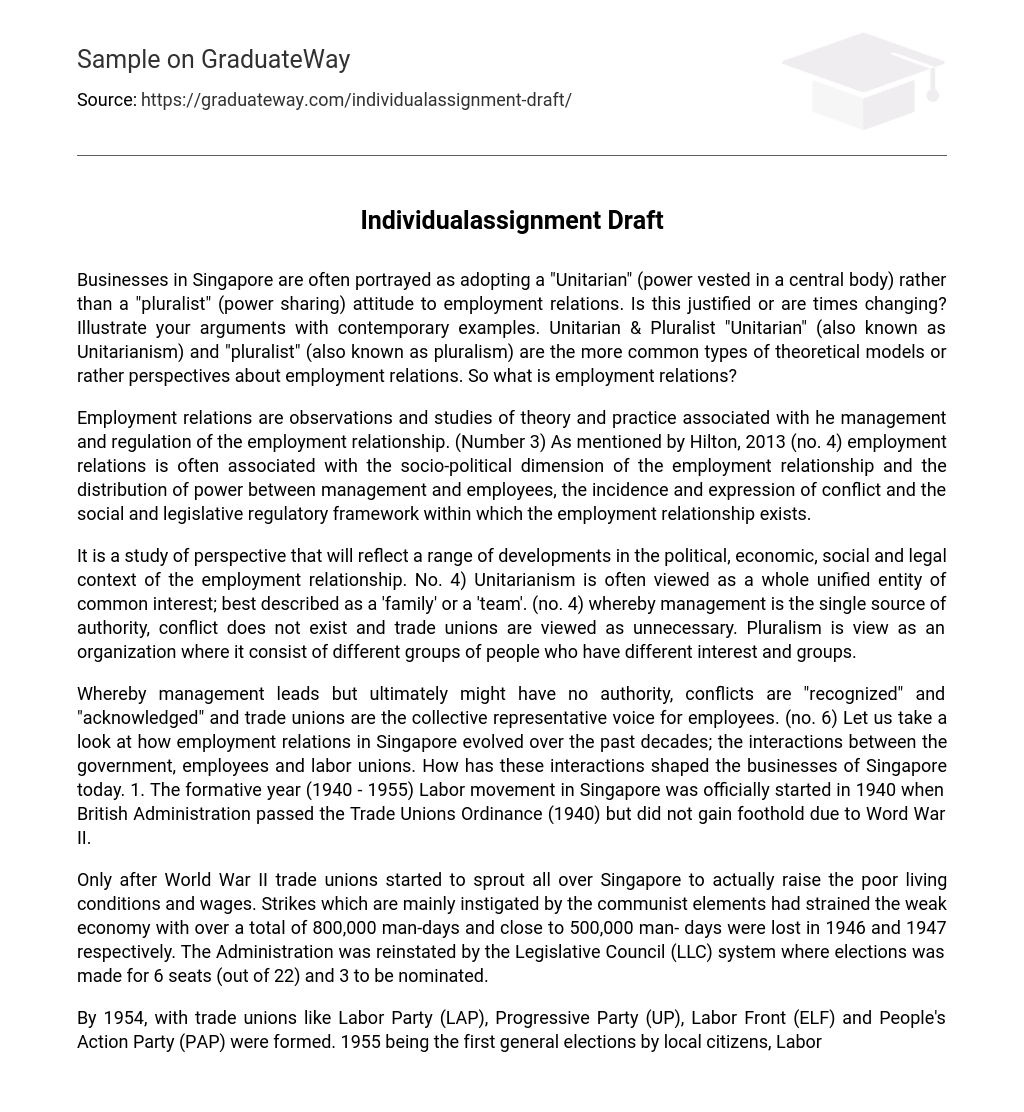Businesses in Singapore are often portrayed as adopting a “Unitarian” (power vested in a central body) rather than a “pluralist” (power sharing) attitude to employment relations. Is this justified or are times changing? Illustrate your arguments with contemporary examples. Unitarian & Pluralist “Unitarian” (also known as Unitarianism) and “pluralist” (also known as pluralism) are the more common types of theoretical models or rather perspectives about employment relations. So what is employment relations?
Employment relations are observations and studies of theory and practice associated with he management and regulation of the employment relationship. (Number 3) As mentioned by Hilton, 2013 (no. 4) employment relations is often associated with the socio-political dimension of the employment relationship and the distribution of power between management and employees, the incidence and expression of conflict and the social and legislative regulatory framework within which the employment relationship exists.
It is a study of perspective that will reflect a range of developments in the political, economic, social and legal context of the employment relationship. No. 4) Unitarianism is often viewed as a whole unified entity of common interest; best described as a ‘family’ or a ‘team’. (no. 4) whereby management is the single source of authority, conflict does not exist and trade unions are viewed as unnecessary. Pluralism is view as an organization where it consist of different groups of people who have different interest and groups.
Whereby management leads but ultimately might have no authority, conflicts are “recognized” and “acknowledged” and trade unions are the collective representative voice for employees. (no. 6) Let us take a look at how employment relations in Singapore evolved over the past decades; the interactions between the government, employees and labor unions. How has these interactions shaped the businesses of Singapore today. 1. The formative year (1940 – 1955) Labor movement in Singapore was officially started in 1940 when British Administration passed the Trade Unions Ordinance (1940) but did not gain foothold due to Word War II.
Only after World War II trade unions started to sprout all over Singapore to actually raise the poor living conditions and wages. Strikes which are mainly instigated by the communist elements had strained the weak economy with over a total of 800,000 man-days and close to 500,000 man- days were lost in 1946 and 1947 respectively. The Administration was reinstated by the Legislative Council (LLC) system where elections was made for 6 seats (out of 22) and 3 to be nominated.
By 1954, with trade unions like Labor Party (LAP), Progressive Party (UP), Labor Front (ELF) and People’s Action Party (PAP) were formed. 1955 being the first general elections by local citizens, Labor Front (ELF) won the most support having to capitalized on labor concerns. Txt) 2. The Hock Lee Bus Riot (1955) It was mainly the struggle between the communist elements where communist wanted to set up a communist state. The largest number of new strikes and man- days lost in Gasolier’s labor relations as close to 1 million man-days were lost due to 275 new strikes.
Having at that time of population close to 1 million, the industrial relations scene was viewed as a chaos. These strikes showed the crippling effects that a workplace with poor industrial relations would cause to an economic system. The Hock Lee bus riot was ended when the government pointed arbitrator made a ruling. 3. Labor Movement and the search for a development strategy (1963-1972) Merger with the Malaysian Federation was motivated by the prospect to have a more secure future for Singapore in hope that the Malaysian federation would offer a bigger common market for Singapore.
With thoughts to better survive the economic stagnation and security threats posted by the communists, Singapore joined. However, due to racial disputes of differential treatment between Muslims and other races, racial riots happened. This further complicate the disputes between Singapore and Malaysia Federation on economic and financial matters. On August 9, 1965, Singapore was expelled from Malaysian Federation to become an independent state. Given Singapore being a small island with limited land and resources, the high unemployment rate rose to 10-12% following the becoming of independent state.
To further worsen the state, British announced in 1967 to withdraw its defense force which could lead to about 400,000 people to be unemployed. Therefore, Singapore having to deal with this explosion of unemployment; General elections was brought forward to seek citizens’ mandate of the economic changes. 2 ajar employment-related laws was introduced to attract foreign investors and companies to shift operations to Singapore, the ‘industrial relations act’ and ’employment act’. 4.
Labor Unions as a strategic partner in economic progress (1972-1985) National Wage Council (NC) was set up to make annual adjustment recommendations at national level with no legal binding accordingly to nation’s economy. Having all through the past decades, Singapore has come far in laying all the grounds for a better working environment and being competitive in the market. Attracting companies to locate labor jobs in Singapore since we are of small island with limited land and infrastructure.





